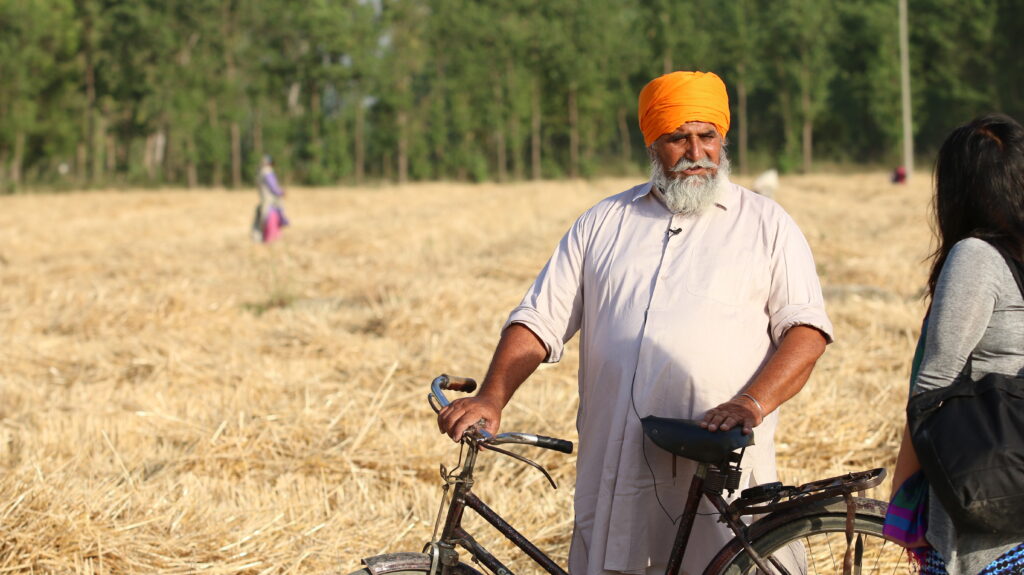Communications Specialists Vidushi Sinha and Joslin Isaacson were in India recently to capture footage of zinc wheat. Here’s their behind-the-scenes take on their trip.
The HarvestPlus team in India travelled from Chennai in the southern state of Tamilnadu to locations in the northern states of Uttarakhand and the Punjab—nearly spanning India’s north to south. Their mission was to see the golden fields of biofortified zinc wheat, and to talk to Dr. M.S. Swaminathan, the father of India’s “Green Revolution.” The Green Revolution in the mid-1960s significantly increased the yield of primarily wheat and rice through the introduction of high yield variety seeds.
Several decades later, Dr. Swaminathan is still a leading voice for agriculture in India—advocating sustainable agriculture and biofortification. According to Dr. Swaminathan “biofortified crops such as zinc wheat and rice will be a very effective strategy to end malnutrition in India.” We spent an entire day with Dr. Swaminathan at the Swaminathan Research Foundation (MSSRF) in Chennai. Later in the evening we flew to Delhi.
The next day we left for Punjab by car with our local cameraman, Neeraj Tiwari and his assistant, Murli Prasad. We wanted to document each and every step in the zinc wheat value chain. After several hours, our team reached Uttarakhand, located in northern India, where we first met Mr. Sumant Sood, the CEO of Sood Seeds Pvt. Limited, a company dealing in zinc wheat.
Seed companies like Sood Seeds are so committed to marketing zinc wheat seeds that they have contracted several farmers to grow these seeds on hundreds of acres of land at the foothills of the Himalayas. At one such farm, in Bazpur, Uttarakhand, we met seventy-one-year-old farmer Swarn Singh and his family. Swarn Singh and his two sons manage their 22 acres of land. Jagjeet Kaur, his wife of 36 years, said “My husband and I always worked together in the fields when we were younger. We started from scratch, we owned nothing, not even a bicycle. Now we have so much, three cars, a tractor, cows, such a big house, we have everything.” After years of hard work, Swarn Singh is in the enviable position of being a prosperous farmer and a respected member of the community.
Swarn Singh is also a major link between Sood Seeds and a number of farmers who grow zinc wheat seeds in Uttarakhand. Sood Seeds supplies zinc wheat seeds to the entire northern India.
The next morning we left the foothills of the Himalayas for the land of five rivers, Punjab (Punj means five and Ab means water, standing for river). After a grueling ten-hour road trip, we reached Jalandhar in Punjab, a city that was all set to celebrate with farmers the festival of Baisakhi, marking the first day of harvest season. We were soon in the zinc wheat fields with farmers who were counting wheat grains on top of wheat bushels. One of them, General Singh, walked up to us and said, “There is so much more grain in this zinc wheat variety than the regular variety that we have. This variety is standing tall and did not even bend during the storm and rain that we had last week. I think I will be sowing this variety next season.”
The following day we reached Ludhiana, a major city in the Punjab, to meet with the CEO of a big flour mill. Mr. D. C. Singala of Arti flour mill told us, “We are so ready for zinc wheat flour. I have been promoting this with retailers, and selling it at a price that is not profitable for my company at all but I believe people will like this and soon I will be making profits.” The flour retailer whom we met in Khanna, another city close by, said further, “People keep asking for this flour. I have many return customers. They say it is so much better than other brands of flour that I sell in my store.”
In Khanna, we also met consumers of zinc wheat. One of the mothers who cooked “rotis” made of zinc wheat flour for her three children said, “My kids like the roti made of this flour so much better. Their appetite gets better because my five year old who usually eats just one roti, can eat two when I use this flour.”
We rounded off the trip by meeting with the researchers who have conducted our wheat efficacy study.
It was already ten days on the road and time to say goodbye to all in India. Parminder Virk, our anchor, enabler, and the most enthusiastic and energetic crop scientist, hosted a wonderful dinner for the team to wish us good luck working with the footage. Neeraj, our cameraman and Murli, his assistant, said goodbye with promises of keeping in touch. Parveen Singh, our trusted and reliable taxi driver, said he will always be available for us should we make another trip in the future. We left India with a heavy heart and tons of footage. Please stay tuned and visit our website again for our upcoming wheat stories.
